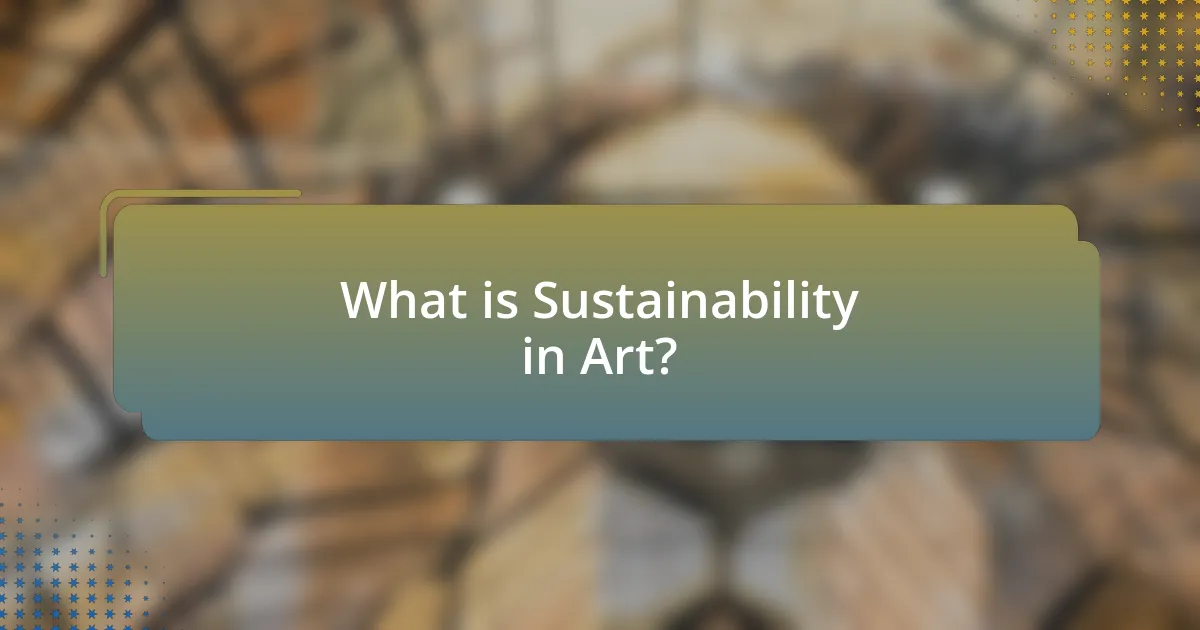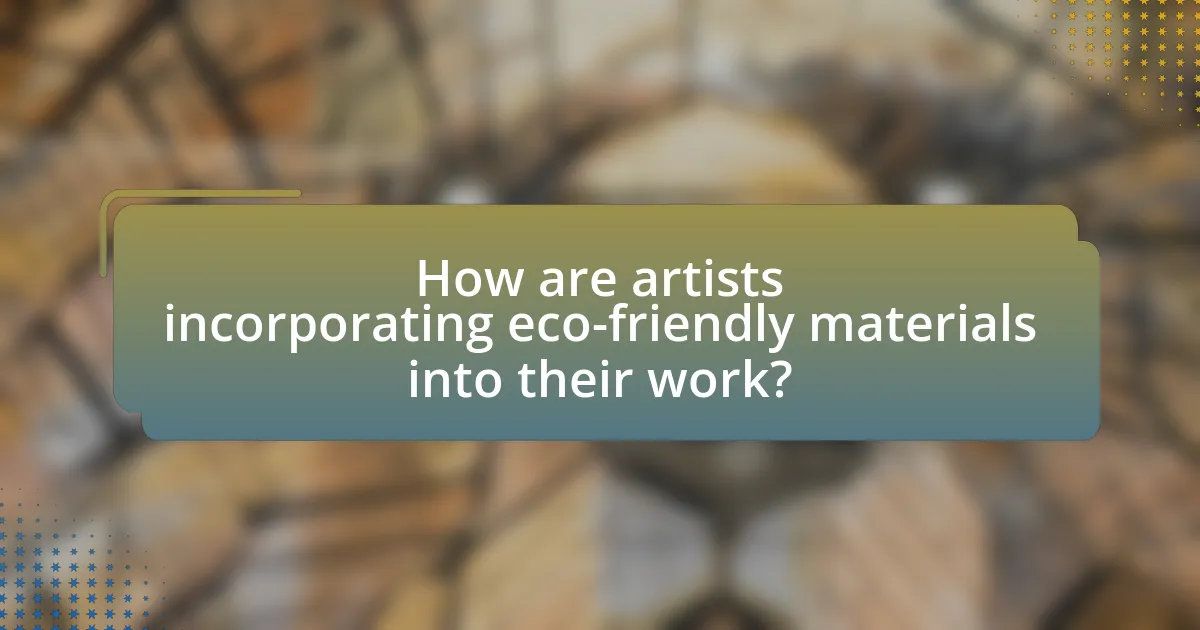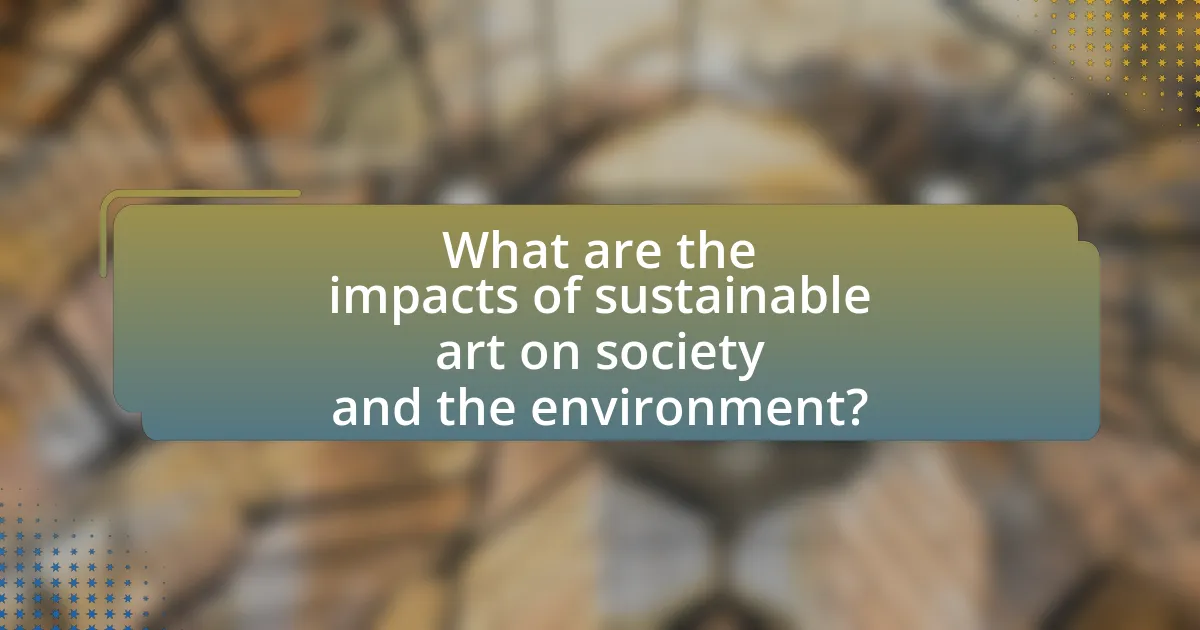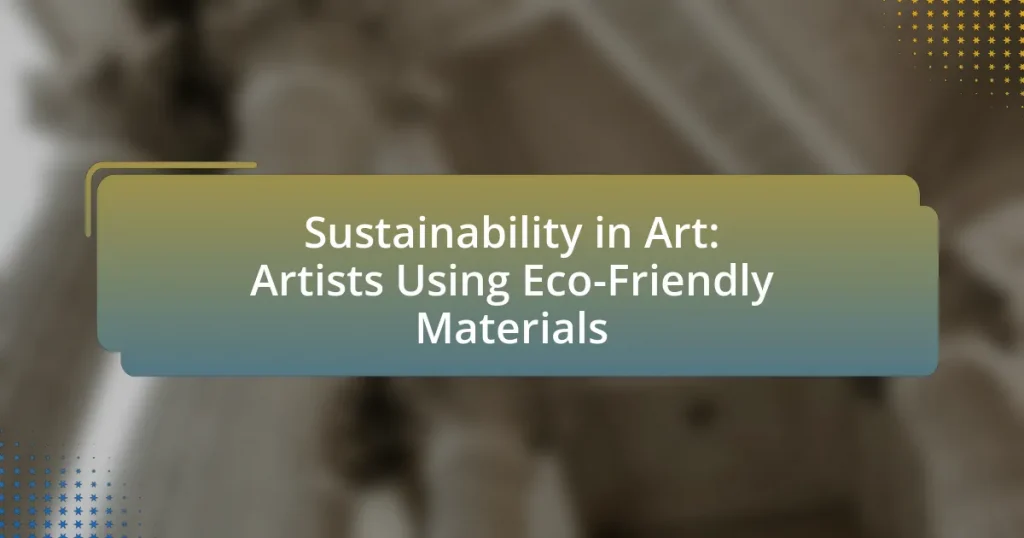Sustainability in art refers to the practice of creating artworks that minimize environmental impact through the use of eco-friendly materials and processes. This article explores the significance of sustainability in the art world, highlighting how artists are increasingly adopting eco-friendly materials to reduce waste and promote ecological awareness. It examines the environmental implications of traditional art materials, defines eco-friendly options, and discusses the challenges artists face in sourcing and utilizing these materials. Additionally, the article showcases notable artists and projects that exemplify sustainable practices, emphasizing the role of art in fostering community engagement and raising public awareness about environmental issues.

What is Sustainability in Art?
Sustainability in art refers to the practice of creating artworks that minimize environmental impact through the use of eco-friendly materials and processes. This approach emphasizes the importance of reducing waste, conserving resources, and promoting ecological awareness within the art community. For instance, artists may utilize recycled materials, non-toxic paints, and sustainable sourcing methods to create their works, thereby contributing to a more sustainable art ecosystem. The integration of sustainability in art not only addresses environmental concerns but also encourages a dialogue about the role of art in fostering social and ecological responsibility.
Why is sustainability important in the art world?
Sustainability is important in the art world because it addresses environmental concerns and promotes responsible resource use. Artists increasingly utilize eco-friendly materials and practices to minimize their ecological footprint, reflecting a growing awareness of climate change and environmental degradation. For instance, a study by the Art and Ecology Research Group at the University of the Arts London found that sustainable art practices can significantly reduce waste and carbon emissions associated with traditional art production methods. This shift not only fosters innovation in artistic expression but also encourages a broader cultural movement towards sustainability, making it a vital aspect of contemporary art.
How does sustainability impact artistic practices?
Sustainability significantly impacts artistic practices by encouraging artists to adopt eco-friendly materials and methods. This shift leads to the creation of artworks that not only minimize environmental harm but also raise awareness about ecological issues. For instance, artists increasingly utilize recycled materials, biodegradable substances, and sustainable production techniques, which contribute to a reduced carbon footprint. A notable example is the work of artists like El Anatsui, who transforms discarded materials into intricate sculptures, highlighting the potential of waste in art. This approach not only fosters innovation in artistic expression but also aligns with global sustainability goals, as evidenced by initiatives like the “Green Art” movement, which promotes environmentally conscious practices in the arts.
What are the environmental implications of traditional art materials?
Traditional art materials often have significant environmental implications due to their production processes and chemical compositions. For instance, oil paints contain solvents and heavy metals, which can lead to soil and water contamination during disposal. Additionally, the production of traditional materials like paper and canvas contributes to deforestation and habitat loss, as well as high energy consumption and greenhouse gas emissions. Studies indicate that the art supply industry generates substantial waste, with many materials being non-biodegradable, thus persisting in landfills for extended periods. The use of toxic substances in traditional art materials poses risks not only to the environment but also to artists’ health, as exposure can lead to respiratory issues and other health problems.
What defines eco-friendly materials in art?
Eco-friendly materials in art are defined by their minimal environmental impact, sustainability, and non-toxicity. These materials are often derived from renewable resources, such as natural fibers, plant-based pigments, and recycled substances, which reduce waste and pollution. For instance, artists may use organic cotton, bamboo, or recycled paper, which not only lessen the carbon footprint but also promote biodiversity. Additionally, eco-friendly materials are free from harmful chemicals, ensuring safety for both the artist and the environment. The use of such materials aligns with the principles of sustainability, as evidenced by the growing trend among artists to adopt practices that support ecological balance and conservation.
Which materials are considered eco-friendly for artists?
Eco-friendly materials for artists include organic paints, recycled paper, bamboo brushes, and natural fibers. Organic paints are made from natural pigments and do not contain harmful chemicals, making them safer for both the artist and the environment. Recycled paper reduces waste and minimizes the need for new resources, while bamboo brushes are sustainable due to the rapid growth of bamboo and its minimal environmental impact. Natural fibers, such as cotton and hemp, are biodegradable and often produced without harmful pesticides, further supporting eco-friendly practices in art.
How do eco-friendly materials differ from conventional materials?
Eco-friendly materials differ from conventional materials primarily in their environmental impact and sustainability. Eco-friendly materials are sourced from renewable resources, biodegradable, and often produced with minimal energy consumption, reducing their carbon footprint. In contrast, conventional materials typically rely on non-renewable resources, may contain harmful chemicals, and often contribute to pollution during production and disposal. For example, organic cotton, a common eco-friendly material, uses less water and avoids synthetic pesticides compared to conventional cotton farming, which is associated with significant environmental degradation.

How are artists incorporating eco-friendly materials into their work?
Artists are incorporating eco-friendly materials into their work by utilizing sustainable resources such as recycled paper, organic pigments, and biodegradable substances. For instance, many painters are now opting for natural dyes derived from plants instead of synthetic colors, which reduces environmental impact. Additionally, sculptors are increasingly using reclaimed wood and metal, which not only minimizes waste but also adds unique character to their pieces. Research indicates that the global market for sustainable art materials is growing, reflecting a shift in consumer demand towards environmentally responsible practices in the art community.
What techniques do artists use to create sustainable art?
Artists use techniques such as utilizing recycled materials, employing natural pigments, and adopting eco-friendly processes to create sustainable art. By incorporating recycled materials, artists reduce waste and promote a circular economy; for example, using discarded plastics or reclaimed wood in their works. The use of natural pigments, derived from plants and minerals, minimizes the environmental impact associated with synthetic dyes and paints. Additionally, artists often implement eco-friendly processes, such as water-based adhesives and non-toxic finishes, to further reduce their ecological footprint. These techniques collectively contribute to a more sustainable art practice, aligning with the growing emphasis on environmental responsibility in the art community.
How do artists source eco-friendly materials?
Artists source eco-friendly materials by researching suppliers that specialize in sustainable products, utilizing recycled or upcycled materials, and opting for natural pigments and non-toxic adhesives. Many artists engage with local artisans and eco-conscious brands to ensure their materials have minimal environmental impact. For instance, a study by the American Craft Council highlights that artists increasingly prioritize materials that are certified organic or sourced from renewable resources, reflecting a growing trend towards sustainability in the art community.
What role does innovation play in sustainable art practices?
Innovation is crucial in sustainable art practices as it drives the development of eco-friendly materials and techniques that minimize environmental impact. Artists leverage innovative approaches to create works that not only express their vision but also adhere to sustainability principles, such as using recycled materials, biodegradable substances, and energy-efficient processes. For instance, the use of non-toxic paints and sustainable sourcing of materials reduces harmful waste and promotes environmental stewardship. This shift towards innovation in art not only enhances the aesthetic value but also raises awareness about ecological issues, encouraging both artists and audiences to engage with sustainability actively.
What challenges do artists face when using eco-friendly materials?
Artists face several challenges when using eco-friendly materials, primarily related to availability, performance, and cost. Eco-friendly materials are often less accessible than traditional options, limiting artists’ choices and requiring additional effort to source them. Furthermore, these materials may not perform as well in terms of durability, color vibrancy, or ease of use, which can hinder the creative process. Additionally, the cost of eco-friendly materials can be higher, making it financially challenging for artists, especially those on tight budgets. These factors collectively impact the feasibility of incorporating sustainable practices into their work.
How do cost and availability affect the use of sustainable materials?
Cost and availability significantly influence the use of sustainable materials in art. When sustainable materials are expensive or scarce, artists may opt for conventional materials that are more affordable and readily available. For instance, a study by the Ellen MacArthur Foundation highlights that the cost of recycled materials can be up to 50% higher than virgin materials, which discourages artists from using them. Additionally, limited access to sustainable options can lead to a reliance on traditional materials, undermining efforts to promote eco-friendly practices in the art community.
What are the limitations of eco-friendly materials in art creation?
Eco-friendly materials in art creation often face limitations such as reduced durability, limited color range, and higher costs. For instance, natural pigments may fade more quickly than synthetic alternatives, impacting the longevity of artworks. Additionally, some eco-friendly materials, like biodegradable glues or paints, may not adhere as effectively or provide the same finish as traditional materials, which can hinder artistic expression. Furthermore, the sourcing of sustainable materials can be more expensive, making it challenging for artists to maintain affordability in their work. These factors collectively restrict the versatility and practicality of eco-friendly materials in the art-making process.

What are the impacts of sustainable art on society and the environment?
Sustainable art positively impacts society and the environment by promoting eco-consciousness and reducing waste. Artists utilizing eco-friendly materials often raise awareness about environmental issues, encouraging communities to engage in sustainability practices. For instance, a study published in the Journal of Environmental Psychology found that art installations made from recycled materials significantly increased public interest in recycling initiatives, leading to a 30% rise in local recycling rates. Additionally, sustainable art practices contribute to the reduction of carbon footprints by minimizing the use of harmful substances and promoting the use of renewable resources. This dual impact fosters a culture of sustainability, influencing societal values and behaviors towards environmental stewardship.
How does sustainable art influence public awareness of environmental issues?
Sustainable art significantly influences public awareness of environmental issues by using eco-friendly materials and themes that highlight ecological concerns. Artists who engage in sustainable practices often create works that provoke thought and discussion about climate change, pollution, and resource depletion. For instance, the use of recycled materials in art installations not only reduces waste but also serves as a visual representation of the importance of recycling and sustainability. Research indicates that art can evoke emotional responses, making complex environmental issues more relatable and urgent to the public. A study published in the journal “Environmental Communication” found that art can effectively raise awareness and inspire action regarding environmental challenges, demonstrating its power as a tool for social change.
What role does art play in promoting sustainability?
Art plays a crucial role in promoting sustainability by raising awareness about environmental issues and inspiring action through creative expression. Artists often utilize eco-friendly materials and practices, which not only reduce waste but also serve as a powerful statement about the importance of sustainable living. For instance, the use of recycled materials in artworks can demonstrate the potential for repurposing waste, thereby encouraging audiences to rethink their consumption habits. Additionally, art installations that address climate change or biodiversity loss can engage the public emotionally, fostering a deeper connection to sustainability efforts. This intersection of art and sustainability is evident in initiatives like the “Art for the Earth” project, which showcases works that highlight ecological themes and promote environmental stewardship.
How can sustainable art contribute to community engagement?
Sustainable art can significantly contribute to community engagement by fostering collaboration and raising awareness about environmental issues. Artists who utilize eco-friendly materials often involve local communities in the creation process, encouraging participation and dialogue around sustainability. For instance, community art projects that incorporate recycled materials not only beautify public spaces but also educate participants about waste reduction and resource conservation. Research indicates that such initiatives can enhance social cohesion and empower individuals, as seen in projects like the “Trash to Treasure” initiative in various cities, which successfully engaged residents in transforming waste into art, thereby promoting environmental stewardship and community pride.
What are some notable examples of artists using eco-friendly materials?
Notable examples of artists using eco-friendly materials include Chris Jordan, who creates large-scale photographic works from recycled materials, and El Anatsui, who utilizes discarded bottle caps and aluminum to craft intricate sculptures. Additionally, the artist Agnes Meyer-Brandis employs natural materials like clay and plant fibers in her installations, emphasizing sustainability. These artists demonstrate a commitment to environmental consciousness by incorporating recycled and natural elements into their art, effectively raising awareness about sustainability issues.
Who are leading artists in the sustainable art movement?
Leading artists in the sustainable art movement include Olafur Eliasson, Agnes Meyer-Brandis, and Chris Jordan. Olafur Eliasson is known for his installations that engage with climate change and natural phenomena, often using eco-friendly materials. Agnes Meyer-Brandis focuses on the intersection of art and environmental awareness, creating works that highlight ecological issues. Chris Jordan’s photography critiques consumerism and waste, using visual narratives to raise awareness about sustainability. These artists exemplify the integration of environmental consciousness into their creative practices, making significant contributions to the sustainable art movement.
What projects exemplify the use of eco-friendly materials in art?
Projects that exemplify the use of eco-friendly materials in art include the “Plastic Ocean” installation by artist Angela Haseltine Pozzi, which utilizes marine debris to raise awareness about ocean pollution. Another notable project is “The Greenhouse” by artist and architect David Benjamin, which incorporates sustainable materials and living plants to create an interactive art installation that emphasizes environmental sustainability. Additionally, the “Earthship” project by Michael Reynolds showcases the use of recycled materials in building structures that are both artistic and functional, promoting sustainable living practices. These projects demonstrate a commitment to environmental consciousness through innovative use of eco-friendly materials in artistic expression.
What practical tips can artists follow to create sustainable art?
Artists can create sustainable art by using eco-friendly materials, reducing waste, and adopting sustainable practices. For instance, artists can choose non-toxic paints, recycled paper, and natural fibers, which minimize environmental impact. Additionally, implementing techniques such as upcycling found objects or using digital mediums can significantly reduce material waste. Research indicates that the art industry contributes to pollution and waste, so adopting these practices not only benefits the environment but also aligns with growing consumer demand for sustainability in art. By prioritizing sustainability, artists can contribute to a healthier planet while maintaining their creative expression.
How can artists effectively transition to using eco-friendly materials?
Artists can effectively transition to using eco-friendly materials by researching sustainable alternatives and gradually incorporating them into their practice. This involves identifying non-toxic paints, recycled papers, and biodegradable mediums that align with their artistic vision. For instance, a study published in the Journal of Cleaner Production highlights that artists who switch to water-based paints reduce harmful emissions significantly, thus promoting a healthier environment. Additionally, artists can participate in workshops focused on eco-friendly techniques, which provide practical knowledge and resources for sustainable art-making.
What resources are available for artists interested in sustainability?
Artists interested in sustainability can access various resources, including organizations, online platforms, and educational materials. Notable organizations such as the Center for Sustainable Practice in the Arts provide guidelines and support for integrating sustainability into artistic practices. Online platforms like EcoArtSpace offer a community for artists focused on environmental issues, showcasing projects and providing networking opportunities. Additionally, educational resources such as the book “Sustainable Art: A Handbook for Artists” by David P. McCarthy outline practical approaches to using eco-friendly materials and methods. These resources collectively empower artists to adopt sustainable practices in their work.














